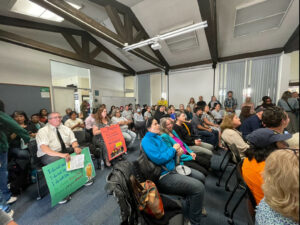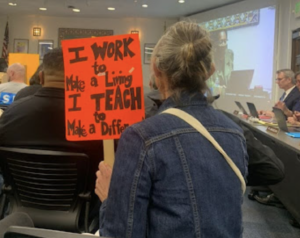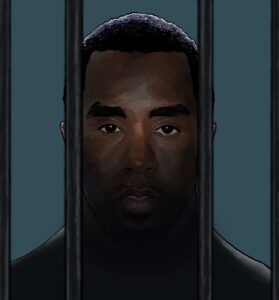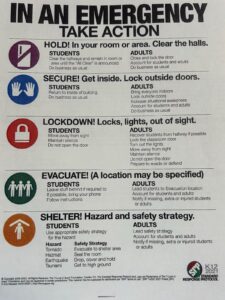Across the United States, various union issues and strikes– like those in the Los Angeles school district last year or SAG-AFTRA– have been a common source of stress for the American public. When SBHS students attend school in the morning, many are too focused on their upcoming game or math test to think that these issues that they hear about could be taking place in their own hometown. Whether students are aware of it or not, the teachers that are supposed to guide us towards our future are dealing with uncertainty in their own future in this district.
One of the biggest concerns within the Santa Barbara Teachers Association (SBTA) is teacher retention. Over the last two years, Santa Barbara Unified School District (SBUSD) has lost and replaced about 100 teachers, but broader issues of decreasing teacher retention became a concern about five years ago. Many educators attribute this high turnover rate to large class sizes, high caseloads for special education teachers, lack of prep time, and insufficient salaries in comparison to Santa Barbara’s cost of living. Three years ago, SBUSD and SBTA reached an agreement for a guaranteed 8% salary increase for the 2021-2024 school years. Part of this agreement was that there was to be no more negotiations or reopeners on wages or benefits. This became a source of contention as inflation and rents in Santa Barbara skyrocketed within the past few years and salaries of neighboring districts have seen a drastic increase. This year, negotiations for the salaries of the 2024-2025 school year reopen, making it a historic moment for our school and the educators we see every day.
Is the administration doing everything in its power to address the concerns of educators in this district? This question has been the cause for many lively rallies and debates, as was the case in the most recent rally on August 22. As Ashley Cornelius, SBHS science teacher as well as SBTA board and negotiation team member, put it, “I think that the district has the resources. On the bargaining team we spend a lot of time looking at money and last year we could see that there was a lot of extra money sitting in some accounts…We just want that extra money to go to teachers so that people can afford to live here. It’s frustrating when you feel like the money is there and if they really wanted to do something they could, but it seems like we’re going to have to fight for it…Just because we’re asking for more money, it isn’t a selfish or unreasonable ask.”
According to Kate Lambert, a special education teacher and organizing lead for the union, neighboring school districts like Ventura and Oxnard have seen salary increases between 13 to 20 percent over the past year and a half, a dramatic difference compared to the 8% received in Santa Barbara. Both Lambert and Cornelius said that they would like to see SBUSD educators receiving salary increases that are competitive with those of neighboring districts. “It’s hard for us to attract teachers if we don’t pay as much as neighboring districts…One of the hardest things for people to let go of is money…And it is a lot of people and a lot of money, but our district has a lot of money,” Lambert said.
While SBUSD may appear to have a high average teacher salary in comparison to other parts of California, inflation and incredibly high costs of living in Santa Barbara have forced many teachers out of the district. Sculpture teacher and SBTA organizing team member Kat Ross described the situation, saying, “There’s a cost of living problem…A first year teacher is paid just over $3,500 a month…And if they have to pay for the ‘good’ health care, then that’s around $580 a month, so that’s less than $3,000 a month of take-home pay. One bedroom apartments in Santa Barbara are around $3,000 a month. You can see how they have no money left for food, or laundry, or electricity.”
Jose Caballero is an active member of the SBHS community as Academic Senator, as well as teaching small scale food production, organic gardening, and AP Environmental Science. Caballero shared, “Santa Barbara is really expensive, and a big issue for all of us is that teachers aren’t really paid very well. Maybe the district doesn’t have the money, maybe they’re not spending it on the right things, but I think a lot of people are a little frustrated that…we just can’t pay our bills…My wife and I are both teachers. We’ve been here for 20 years…I feel like the community really respects and supports me [but] I can’t really afford to stay. I worked hard to have a solid education, I went to university and [have] all these graduate degrees, and the fact that I can’t live here is frustrating. I feel like I’m just fighting for students and trying to come back tomorrow so I can keep fighting for students.” As the school year starts, all eyes are on the district to see how they address such concerns from their employees.
The word “strike” has been a common source of stress for students and other community members, but it’s not an outcome that teachers want to reach. According to Lambert, “Teachers don’t want to strike. That means that we aren’t with our students, that means our timelines for what we want to do in our classroom falls behind. It also means we don’t get paid, and if we’re struggling for money that’s a big deal.” While the possibility of a strike isn’t appealing, some teachers think that there is a real likelihood based on the district’s response in the past. Cornelius agrees with the fact that it’s not an option that educators are excited about, but she also thinks that there’s “over a 50% chance” that they will have to strike. However, an SBTA majority vote of 90% is needed in order to strike. One teacher said, “I think [the district’s] responses to the union’s demands in the past have indicated that they are not overly concerned about meeting the union’s demands…I’m continually surprised that the district is not more interested in a collaborative working relationship with their own employees.” Before the need to strike is reached, union leadership will be meeting with teachers from every school site until the end of September to establish the most important demands from educators and signing a public petition. Later, SBTA and SBUSD will be meeting at the negotiating table to try and reach an agreement in good faith.
The beginning of the year is an important time for students, but it’s also the beginning of the long process of negotiations between the district and educators. As the school year goes on, the future of our teachers and education hangs in the balance.
[Image courtesy of Krystine Hastie]









Be First to Comment